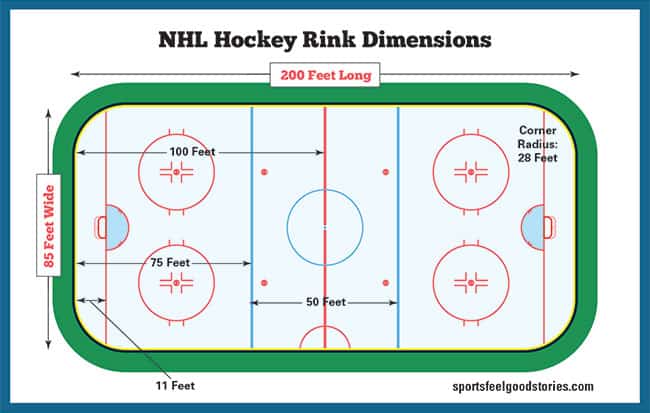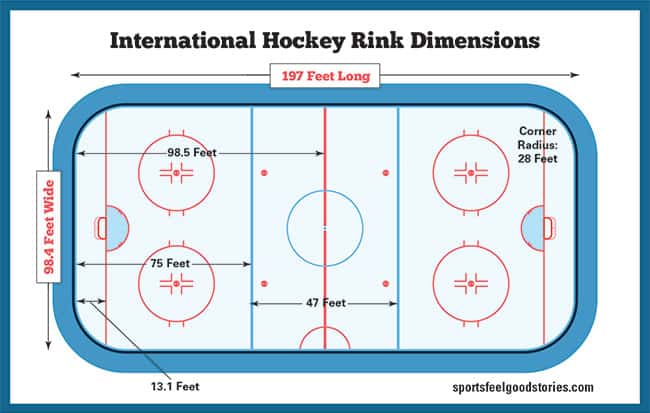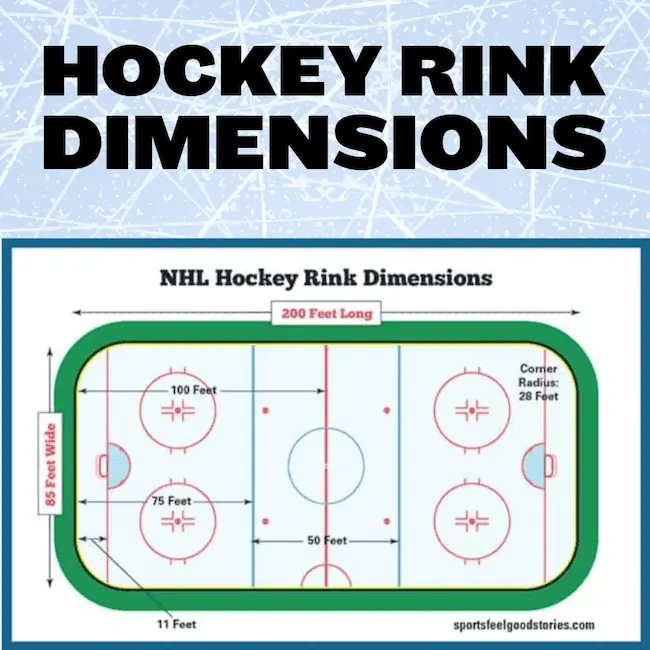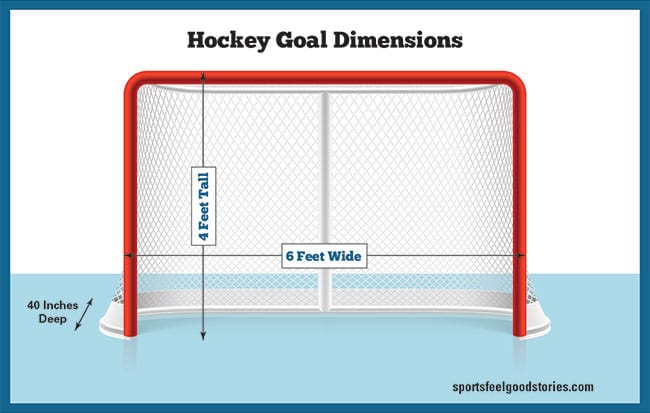There are typically two different standards for ice hockey rink dimensions and size. The North American rink size is also the standard for the NHL. The other most common rink size is the European-size rink or International rink.
Let’s take a look at some of the important measurements and distances used in hockey.
Hockey Rink Size
The National Hockey League (NHL) rink ice surface is 200 feet long and 85 feet wide. The International Rink ice surface is 197 feet long and 98.4 feet wide.
An international hockey rink is about the same length but considerably wider than an NHL rink. Bigger ice changes the style of play. It provides for a more wide-open style of play with more space and more time. The pace of play tends to be slower, and the game turns to puck possession. Still, a shooter’s angles are not quite as good when forced wide.
As you can see, the blue lines are 50 feet apart from each other or 25 feet from the red line.
NHL Hockey Rink Dimensions Diagram

A line pass going from a player behind one blue line to a player on the far side of the other blue line would travel over 50 feet.
Check out NHL PLayers Pregame Routines.
International Hockey Rink Diagram

The sides of the rink for International Hockey are 98.4 feet apart. The length is 197 feet. These sizes are designated by the International Ice Hockey Federation (IIHF).
What is the Olympic Ice Arena Size?
The Olympic-sized arena ice is generally 60 meters by 30 meters – which is the same 197 feet by 98.4 feet as International rinks. Olympic Ice size allows for a more wide-open game than played in the NHL. Winter Olympic games and International Competitions are played on bigger rink sizes than NHL games.
What are a Hockey Arena’s Zones?
The blue lines on a hockey rink divide it into three zones. The middle zone is called the neutral zone or center ice. The other two zones on each side of the neutral zone are end zones but are even more referred to by the teams’ names that are competing, e.g., “Into the Bruins’ zone.”
The end zone in which a team is attempting to score a goal is referred to as the offensive zone or the attacking zone. A hockey puck must completely cross the blue line to be considered in an end zone. At that point, the blue line is considered part of that zone.
The defending zone is the end zone that a team is trying to defend. It is called the defensive zone.
See 99 Best Hockey Jokes.
What are Faceoff Spots and Faceoff Circles?
In total, there are nine faceoff spots on a hockey rink. All faceoffs during a hockey game take place at these locations on the rink. There are two spots on each team’s defensive ends and one in the center of the ice. And there are two at the end of each neutral zone.
The center faceoff spot and circle are colored blue. All the other face-off spots and face-off circles are colored red. The center faceoff spot is 30 feet in diameter and has an outline of 2 inches thick.
How long is a Hockey Rink?
The length of a hockey rink is 200 feet for a North American rink or NHL rink. The International rink is slightly shorter, at 197 feet (or 60 meters).
You might like What is icing in Hockey?
What is the Outdoor or Backyard Hockey Rink Size?
The outdoor rink can be any size you choose (usually determined by available space), but typically they are much smaller than the professional rink. One common size for young skaters is 46 feet long by 20 feet wide. For older kids and teens, a rink size of 88 by 44 feet is good.
See How Long Is A Hockey Game?
Famous Hockey Rinks
1.) Montreal Forum – The Canadians won the NHL title 22 times while playing their home games at the Montreal Forum. Some of the greats who played there include Rocket Richard, Guy Lafleur, and Ken Dryden.
2.) Maple Leaf Gardens – The Toronto Maple Leafs played here for home games from 1931 to 1999. More “Hockey Night in Canada” games were broadcast from this arena than any other in the NHL.
3.) The Boston Garden – The Bruins called this arena home from 1928 through 1995. While shorter than the regulation size, it was an intimate setting to watch a game. Bobby Orr and Phil Esposito played here.
Check out Zamboni Driver Wins NHL Start.
How Big Is a Hockey Rink?

How Big is a Roller Hockey Rink?
Inline skate or roller hockey rink sizes can vary, but usually, they are 185 feet long by 85 feet wide.
What Size is a Knee Hockey Rink?
Knee hockey rinks measure about 20 feet long by 14 feet wide. Or, it can be played in whatever space is available in a basement. 🙂
Hockey Goal Dimensions
The regulation NHL goal is 6 feet wide by 4 feet high. The net extends 40 inches from front to back.

Hockey Board Dimensions
The wall or boards that encircle the rink stand between 40 and 48 inches tall.
How Big is the Hockey Goal Crease?
The crease or goal crease is the area directly in front of the nets. It’s marked by a red border with a blue interior. Two straight lines extend 4.5 feet perpendicularly from the goal line, one foot outside each goal post. They’re connected by a 6-foot radial line. The lines are 2 inches thick.
Offensive players are not permitted to enter the area unless they have possession of the puck. It’s a way to protect the goalie.
Hockey Puck Size
The black, vulcanized rubber disk used in hockey is typically 1 inch thick and 3 inches in diameter. The weight can vary between 5.5 and 6 ounces.
You might like our Offside in Hockey Definition.
Game Time
Three periods, each lasting 20 minutes, make up a professional hockey game. The total game time is 60 minutes long. Teams switch sides after each period and overtime.
High school and youth hockey game times are sometimes shorter in length, with three 17-minute periods or less.
See What is the Frozen Four in College Hockey?
FAQs about Hockey
When watching a hockey game, a few questions might arise beyond the game’s strategies, tactics, and rules. We’re here to help.
Typically, cold concrete is used to make ice in a multi-stage process. Metal pipes are placed inside the concrete slab under the ice. A refrigeration plant uses freezing-cold glycol that runs through the pipes. This causes the concrete to drop well below the freezing mark. Thin layers of ice are added to build a smooth surface ideal for skating.
The ice is built up in stages to get to .75 total thickness. The first layer of ice is about a half-inch thick. At this point, lines and other markings are painted on the ice – literally painted on. The rink is then flooded and frozen again to get to the final thickness. The lines, logos, and markings show through and remain protected by the last layer of ice.
The ice on a professional ice rink is about .75 inches thick.
What is a Zamboni?
A Zamboni is an ice-resurfacing machine that you’ll see run between periods at hockey games. Named after its inventor Frank J. Zamboni of Philadelphia, it’s become an icon of modern hockey. While it’s a trademarked name, the term is sometimes used generically, if incorrectly, to refer to any ice resurfacing machine.
A Zamboni washes a rink’s ice, shaves it, and leaves a thin layer of water to freeze over and smooth out the surface. Mesmerizing to watch; what kid at a hockey game doesn’t want to drive one of these bad boys?
Why is a hockey jersey sometimes called a “sweater”?
In the early days of the sport, players actually wore sweaters, unlike the thin jersey material of today.
When was the first goalie mask used?
In 1927 Clint Benedict was the first goalie ever to use a mask to protect his face. A mask would not be used again until 1959, when Jaques Plante of the Montreal Canadiens used one after taking a shot to the head with a puck.
Hockey Fun Facts
The game has a rich history. Did you know these fun hockey facts?
Hockey Pucks
1.) The fastest hockey puck shot went 110 miles per hour. Alexander Ryazantsev shot it.
2.) Most NHL games use about a dozen pucks.
3.) The official NHL puck is made by Sherwood Hockey of Canada.
4.) Did you know that hockey pucks are frozen for the game? A frozen puck moves faster and eliminates some bouncing.
5.) A “squid” is the name for the puck in underwater hockey.
6.) In some parts, the first hockey pucks used outdoors were mall chunks of frozen cow dung. (I’m guessing most players would want it to be really cold.)
7.) One nickname for a hockey puck is “biscuit.” Players try to put the biscuit in the basket (the net) for a goal.
Hockey Sticks
A.) The Great One, Wayne Gretzky, used an estimated 9 sticks per game.
B.) Chicago Blackhawks star Stan Mikita invented the curved hockey stick accidentally when he caught his stick in a door.
C.) Hockey players taped their sticks in the early 1900s to protect the wood from being damaged, giving them longer lives. Nowadays, taping may take place for a variety of reasons, including a better grip on the puck, a better grip for the hands, and even so they can write their names easily on it.
Hockey Arena Fun Facts
1.) The Calgary Flames The Saddledome is shaped like a saddle. The city of Calgary appreciates rodeos and cattle shows.
2.) Bridgestone Arena, home to the Nashville Predators, has a stage set up for bands to play during intermissions.
3.) The Prudential Center, home of the New Jersey Devils, features one of the biggest jumbotrons in the world.
4.) There’s an outside party deck at the Phoenix Coyotes Jobing.com Arena so fans can enjoy drinks outside.
5.) The nickname of the Pittsburgh Penguins’ old arena was The Igloo.
By Mike O’Halloran
Mike is an author and editor of Sports Feel Good Stories.
Overtime
You are on our Hockey Rink Dimensions page.
You might also like these hockey links:
